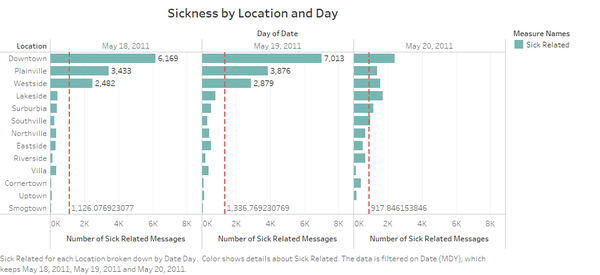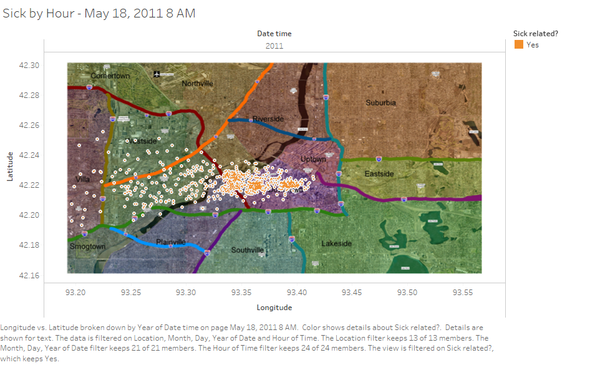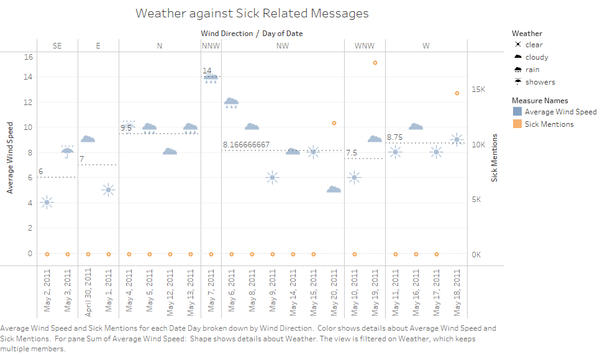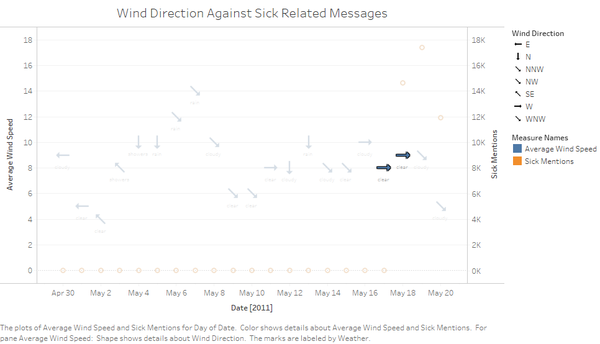ISSS608 2017-18 T1 Assign NURUL ASYIKEEN BINTE AZHAR Transmission
Investigation of Smartpolis Epidemic Outbreak
|
|
|
|
|
|
Contents
What were the Most Affected Areas
Examining the main affected areas would provide clues on the transmission mode of the epidemic. Figure 1 shows that Downtown, Plainville and Westside have the most number of sick related messages for 18 May 2011 and 19 May 2011, well above the average of 1,126 and 1,337 on those days respectively. Downtown dominates the top spot with 6,169 and 7,013 sick messages on 8 May 2011 and 19 May 2011 respectively. Thus, the transmission mode(s) should be in such a manner that can affect these city zones the quickest.
Downtown
Figure 2 examines the first hour since the noticeable surge of disease related messages on 18 May 2011 at 8.10am. From 8 am to 9am, symptoms of the disease were reported the most by Netizens in the Downtown area.
Interestingly, the shape of the messages gives a distinct horizontal shape, towards the East. Such a phenomenon may be explained by the weather conditions on 17 May 2011, during which the incident for Ground Zero occurred, and the days succeeding that. From the previous section on "Ground Zero", we know that the truck collision resulted in a fire. Hence, there is a possibility that the contents on the truck(s) may be harzardous of which a blaze can send harzardous particles airborne.
Figure 3 shows the weather throughout the days where it was sunny for both 17 May 2011 and 18 May 2011; these are the pivotal days for the disease transmission if it is airborne. Since it did not rain, it is highly likely that the harzardous particles remained airborne for imminent transmission.
Figure 4 displays the wind direction across the days. The Eastern wind direction for both 17 May 2011 and 18 May 2011 further explains the shape of the disease spread in Figure 1. If the disease was airborne and the wind direction is Eastern, the disease would spread from Bridge 610 to the Downtown area in a horizontal manner.
Plainville and Westside
We were provided information that the drinking water supply of residents and businesses is through pumping of water from nearby reservoirs or rivers. The Vast River flows down South and both Plainville and Westside are located by the Vast River, downstream. From the previous section on "Ground Zero", we know that contents of the truck(s) spilled out on Bridge 610. There was no mention that the contents spilled into the river, but we may assume so due to the close proximity to the river and high likelihood since it was a major crash. Bridge 610 can be presumed to be small as traffic was a standstill till 9pm due to the accident.
Dashboard Links
Dashboard for Sickness Type by Location and Day
Dashboard for Weather Conditions
Dashboard for Sick Related Messages by Location and Time



